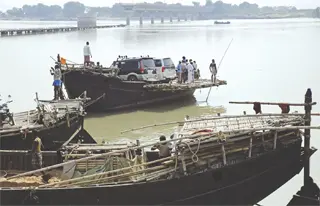Since last month, Baraha Area Water Transport and Tourism Service Private Limited has been conducting test operation of a jet boat on the Koshi River ferrying domestic travelers from Chatara in Sunsari to Bhasuwa of Bhojpur, and Simle of Dhakuta.
The boat, with the capacity of carrying 3.5 tons, can travel both upward and downward ferrying 25-30 travelers each time. The company said the venture, introduced following a substantial feasibility study of more than two years, has been aimed at promoting adventure tourism in Nepal. The jet boat has come into operation at a time when India has agreed to provide Nepal transit facility through waterways for the first time during Prime Minister KP Sharma Oli’s recent visit to India.
Santosh Bhandari, Chairman of Baraha Area Water Transport and Tourism Service, however, said the operation of the jet boat has nothing to do with the bilateral agreement between Nepal and India. “The operation of the jet boat has ascertained that this can be a means of transport in Koshi,” he said.
However, Nepal has to develop cross-border navigation system with India to make it happen. In fact, the two countries have agreed to work jointly to establish a connection with Nepal’s rivers. Development of cross-border waterway could facilitate Nepal’s trade as water navigation is considered as the cheapest and cleanest mode of transport.
A study conducted by CUTS International, an India-based think-tank with the support of Nepal-based think-tank--South Asia Watch on Trade, Economics and Environment (SAWTEE) has also recommended that the government took the initiatives to connect with Indian waterways to ensure reduction of logistic cost of Nepal’s trade substantially.
Making agreement work
Following an agreement signed between Nepal and India, the two sides discussed ways out to accommodate the waterway issue in the Nepal-India Transit Treaty. The issue figured out during the meeting of Inter-Governmental Committee (IGC), a commerce secretary-level forum of two countries held in Kathmandu from April 26-27.
Once the treaty is revised by accommodating the waterways as a mode of transport, it will formally open the door for land-locked Nepal to have direct access to the sea. With India developing its first modern inland water transport fairway on Ganga River between Varanasi and the seaport of Haldia, Kolkata, with the assistance of the World Bank, Nepal could establish connectivity with the planned Indian waterways.
Since no substantial study about the technical possibility of trans-boundary waterway connectivity has taken place, confusion about its viability persists. The government has formed a committee headed by Madhav Belbase, Joint Secretary at the Water and Energy Commission, which has been mandated to work with India and conduct an in-depth study about the hydrological condition of Nepal’s rivers, required depth for water navigation, environmental impact, and economic feasibility of trans-boundary waterway development.
Past studies
In 1966, the first survey about the feasibility of developing inland water transport in Nepal was conducted by a team of domestic and foreign experts when India was constructing the Farraka Barrage. The study found out that Nepal’s rivers were ‘too shallow’ to be navigable all year round. However, the study recommended that the Narayani River was the ‘most suitable’ to be developed as a waterway. In 1980, an inland waterway development project was established at the Ministry of Works and Transport. The department conducted reconnaissance studies in three major rivers - Koshi, Gandaki, and Bheri -- but failed to make any major breakthrough in developing inland navigation.
In 2012, the Ministry of Physical Infrastructure and Transport had commissioned a feasibility study for water transport in the Koshi, Gandaki and Bheri River basins. The study recommended refraining from using commercial water transport for mass passengers and the movement of goods at the present condition. “As these studies were for internal waterway development, developing cross-border waterway needs an extensive study,” Belbase said.
The committee is scheduled to hold the first-ever discussion with the Indian technical team on July 15-16 in Kathmandu. “We will hold talks on conducting joint study of potential of water navigation in Nepal’s river and possible establishment of joint mechanism for the purpose,” Belbase told APD. “We should not only see whether it is technically feasible but also commercially viable.”
 简体中文
简体中文

